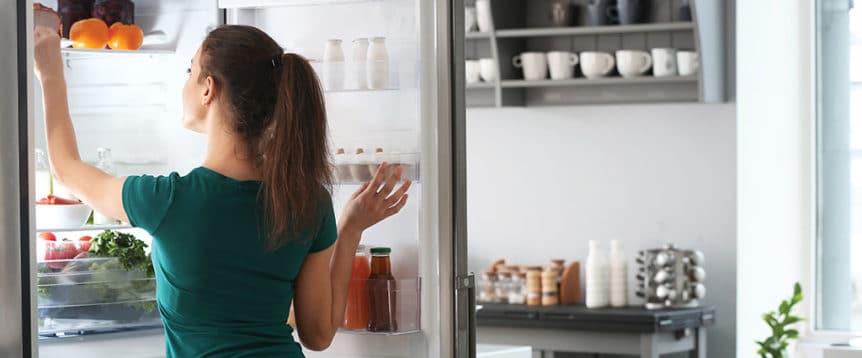Most food consumption takes place in our homes, and what food is available in our refrigerators and pantries usually determines what we end up eating. According to a 2019 study by The Food Industry Association (FMI, formerly Food Marketing Institute), Americans spend an average of $113.50 every week on groceries per household, spread among 1.6 weekly grocery shopping trips. A separate 2020 FMI study found that 91 percent of people in the U.S. feel they eat healthier at home than when dining out. That accounts for a lot of food.
Unfortunately, just over 30 percent of this food can go to waste, according to the USDA’s Economic Research Service. One of the reasons for spoilage is that we simply forget certain things are in the refrigerator. Here are tips to help you organize your fridge and save those forgotten foods from ending up as food waste.
1. Get the smallest size you need.
You’d like to add maraschino cherries to a homemade sundae? The 6-ounce jar should do the trick, rather than the 16-ounce. Need only enough soy milk to get through the week? Opt for the 32-ounce size rather than 64-ounce (half-gallon). This will lessen the temptation to “just go ahead and finish” what’s left in a larger container if you really don’t need it.
2. Clear containers.
In this Marie Kondo style of tidying up, knowing what you have on hand can make all the difference in pinpointing what you make and what you eat. Clear plastic or glass food containers show you more easily how many pieces of leftover veggie pizza, cups of chili or spring rolls are still hanging out in the fridge, so you don’t accidentally make something new.
3. FIFO.
This is food-service lingo for “First In, First Out,” which means that the product you’ve had longest in your refrigerator is in front while your most recent purchases are in the back. This constant- rotating method of using what goes first in your fridge and putting off using the last food added can effortlessly establish a routine of minimizing food waste.
4. Pair up the faves.
Make the perfect snack a no-brainer by stashing goodies that you eat together next to each another in the fridge. Store hummus next to baby carrots, apples next to light caramel dip and celery next to low-fat ranch dressing.
5. Breads go here, too.
The refrigerator isn’t just for perishables anymore. Put your favorite burger buns, sliced bread or bagels in the fridge to promote a longer shelf life for those wholesome grains.
6. Slice and dice when you can.
It’s normal human behavior to default to what’s easiest when making decisions, and that includes food decisions. Put in the time—preferably when you are full after a meal—to chop up some fruits and vegetables so you’re ready when hunger strikes.
7. Keep certain fruits apart.
Did you know some fruits give off a ripening gas called ethylene? This explains why bananas turn brown in mere days (or hours) after purchase. Other fruits like apples, avocados, cantaloupe and peaches are also ethylene-producing and should be kept away from ethylenesensitive items like cauliflower, lettuce and sweet potatoes, so they don’t go bad as quickly.

